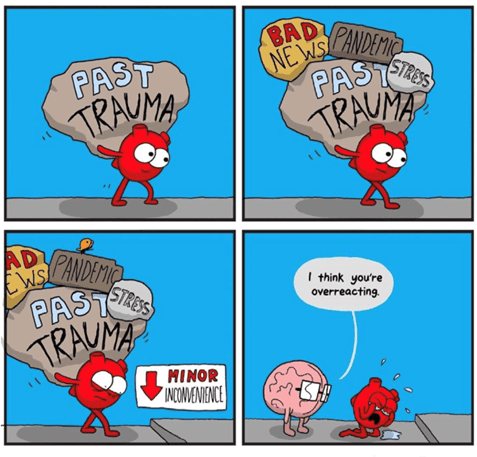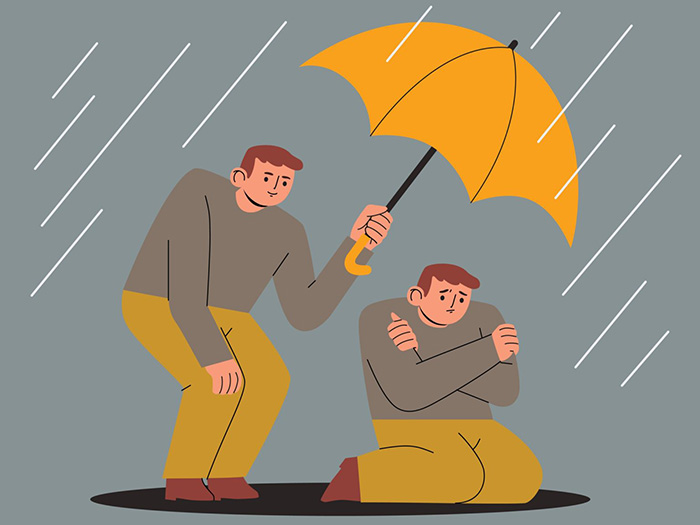A “How-To” Guide for Surviving Survival Mode

What is “Survival Mode”?
Survival mode is essentially booting in “safe mode”. Things like trauma, prolonged grief, or even burnout can cause our brains to opt into booting in this way – it’s basically our brain entering survival mode.
Some sort of trauma may be at the root of your grief, or burnout may just be your experience as you return to work, for example. Trauma can be defined and classified in many ways. And this can feel like a heavy term to many which are why I want to elaborate briefly. Essentially any short or long-term, very stressful experience, can be traumatizing.
Many experienced trauma during the pandemic, including strained relationships due to the pandemic and ongoing stress associated with what we are seeing on the news or in our personal lives.
The trauma responses are Fight, Flight, Freeze, and Fawn. These result in your body saying “essential functions only.” That is why trauma responses often feel like a lack of focus, the “wait, what just happened?” The feeling of reading something five times over and still don’t know what it’s about. Feel like you are operating on a short fuse or simply just exhausted and procrastinating tasks you wouldn’t usually procrastinate.
Your higher-functioning brain has shut down in favor of base survival.

Fight: facing any perceived threat head-on. Fighting is when you feel like you have a chance to win.
Flight: running away from danger. Flight is when you feel you have a chance to escape.
Freeze: unable to move or act against a threat. Freeze is when you can’t fight or flee and feel nothing will protect you.
Fawn: immediately acting to try to please to avoid any conflict. Fawn is that you have discovered a technique that will woo the threat into a more manageable experience that ensures your safety. So, maybe this is people-pleasing.
Each of these responses is our body’s best attempt at survival. And how wonderful! You are here today because of each of those attempts. You have always done the best you can with the information and abilities available to you. These are a continuation of signs & symptoms which you may already notice are happening for you in survival mode, and the way you respond may be different depending on your natural trauma response. These responses may include:
- Forgetting to take care of your basic needs.
- Feel more tired than usual or expected.
- Emotion regulation goes out the window.
- Memory issues
- Multitasking becomes challenging.
Any of these signs and symptoms, coupled with your response, are the early indicators that you may be headed for or are already in survival mode. Being aware of these early indicators, naming them, and responding accordingly, can help manage and prevent living in survival mode.
There are three ways of responding to manage and prevent survival mode. These are self-compassion, self-regulation, and self-care.
SELF-COMPASSION
Self-compassion is a practice of goodwill, not good feelings. With self-compassion, we mindfully accept that a moment is or has been painful and we are still experiencing that pain. Self-compassion is learning to embrace ourselves with kindness and care in response, remembering that imperfection is part of the shared human experience. Here are two tips for practicing this with yourself:
- Let yourself make mistakes. Give yourself permission to be human and remind yourself that you’re not alone in being imperfect. This can help normalize your experience.
- Care for yourself as you’d treat others. If someone you care about is feeling down, hurt, or upset, you might physically pat them on the back or give them a hug. We can tap into our own ‘caregiving system’ to release oxytocin, which has beneficial cardiovascular effects and has been known to reduce the anxiety that is often associated with prolonged stress, burnout, or survival mode in general.

- Become More Self-Aware –Becoming aware of our internal narratives can be a useful starting point for changing our self-talk.
- Use “Releasing Statements.” An alternative to “positive affirmations,” which some claim do not feel natural. When you catch yourself thinking a negative thought, like, I’m such an impatient person for getting upset and reacting the way I did, try “releasing” yourself from the feeling – It’s okay that I felt upset and may have lost patience I usually have. Reacting is just my body’s natural instinct to help me survive.
SELF-REGULATION
Self-regulation is our ability to manage emotions, thoughts, and behaviors in order to reach a positive outcome. We need moments of simple presence every day with awareness of our bodies and a feeling of being grounded. When we’re in survival mode, our thoughts are often directed toward the future—will we make it? Can we hold on? Do we have enough gas in the tank to reach the next filling station? Regulation can bring us back to the present moment and help us mitigate our future thinking anxieties. Self-compassion may promote successful self-regulation by lowering defensiveness and reducing self-blame. Learning to regulate ourselves is crucial so that we can more proactively act rather than impulsively react. Here are some tips:
- “I Am Here” statements: name three things you notice around you or in your body to reground yourself to the present moment.
- Practice mindfulness. Mindfulness practices are a good way to center ourselves in the moment as well. Not only is mindfulness one of self-compassion’s core constructs, but a lot of exercises such as deep breathing can be used anytime, anywhere to self-regulate.
SELF-CARE
If you feel like you are in survival mode, noticing which dimension is impacted and taking care of yourself accordingly can be helpful. Learn more about the Five Dimensions of Wellness with the following article:
Let’s learn more about self-care within these five dimensions.

Spiritual Wellness
What is the reason you do what you do? What is the purpose? Why do you find satisfaction or fulfillment? It’s easy to get burned out and enter survival mode if you can’t see the bigger picture. Get back in touch with why you do what you do. Explore and look for reasons to feel excited again.
Physical Wellness
We may notice that we are in survival mode when we feel like we physically have nothing left to give. We are running on exhaustion and depletion. Rest may be particularly useful here.
- Passive rest: Sleeping, napping, or simply settling into a comfortable position while shutting your eyes or softening your gaze. Anything where you can shut out distractions and settle into a deep, relaxing state.
- Active rest: Yoga, massage therapy, stretching, or deep breathing.
Intellectual Wellness
If you feel your growth is stunted, regressing, you are less engaged or creative, more distracted, or procrastinating even, these may be indicators that you need some intellectual self-care. Find ways to cognitively release or express yourself intellectually.
Social wellness
This can look really different for everyone. If you notice your usual social tendencies are different, this may be your first clue. However, this looks for you, setting aside time to engage with yourself and/or with others is really important for reconnecting and managing survival mode. Connecting with others might also offer a great opportunity to ask for support or to feel less isolated in your experience.
Emotional Wellness
Indicators that we need to be more intentional with self-care emotionally maybe when we or someone else notices that our reactions are more impulsive or unlike what they typically would be.
If you are currently in or anticipating survival mode, practicing self-compassion and self-regulation can help manage survival mode quite a bit. It’s never too late to start engaging in self-care. But more than anything, integrating self-care into your routine and planning for and prioritizing your wellness can also not only help manage survival mode but help prevent it as well.
Here are some final tips:
- Be intentional with exploring meaningful self-care routines. If your current routines aren’t working, try something new. Oftentimes, when we think of self-care, it can be prescriptive – run five miles every day, eat vegetables, take bubble baths, etc. This doesn’t work for everyone and isn’t realistic. Finding your own version of self-care may take some trial and error. Be open to practicing new routines.
- Manage your expectations for yourself. Expecting the same output from yourself every day, regardless of external factors or disruptions, is unreasonable and a recipe for burnout. When you don’t meet your own expectations, practice self-compassion.
- Learn to say “no.”Be honest with yourself and others about your capacity. Saying “no” will support you in managing commitments. Remember, “no” is a full sentence.
- Remain hopeful. Survival mode happens. It is this incredible mode we as humans have to help us SURVIVE! The experiences that accompany survival mode are often challenging to recognize, manage, and prevent. By remaining hopeful, and with a little intentionality, you will learn what the signs and symptoms are in your life, and you’ll be able to practice responding both in the moment and in the long term.
Resource Categories
- Addiction & Substance Use
- Anxiety
- Child Mental Health
- Crisis and Trauma
- Depression
- Exercise
- Just The Facts
- LGBTQIA+ & Pride
- Medicaid
- Men’s Mental Health
- Parenting
- Recovery
- Senior and Older Adult
- Socializing
- Stigma
- Stress
- Suicide Prevention
- Support & Advocacy
- Teen’s Mental Health
- Treatment Options
- Women’s Mental Health